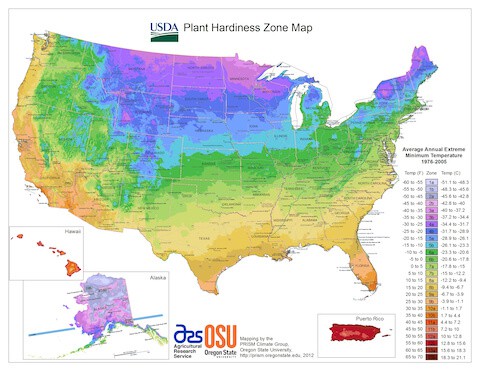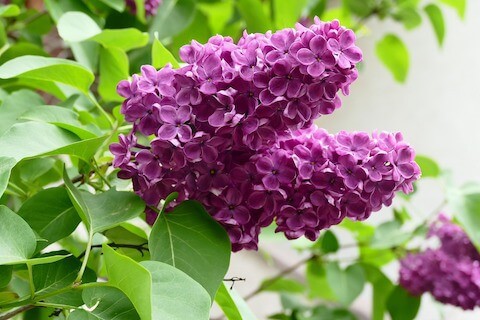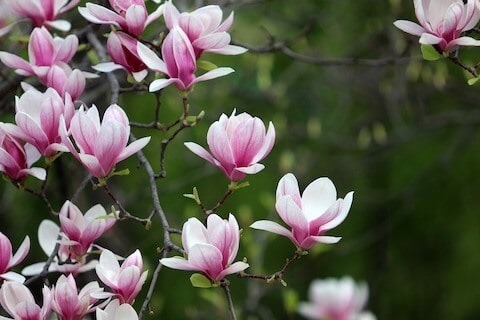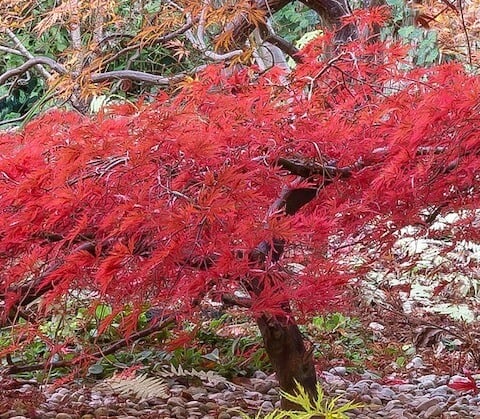With two young kids, finding a quiet place to reflect on the loss of our beloved Pancho was near impossible. That was until we created a place of peace, seclusion and tranquillity, a memorial spot in the garden.
This spot is perfect. Every spring when my Japanese maple is blooming, I sit out in the garden with a cup of tea and remember the wonderful memories Pancho gave my family. It is the perfect tribute to the perfect dog.
Below are the 10 best pet memorial garden plants for your garden. This post breaks it down into 4 memorial shrubs and 6 memorial trees.
- Lilac
- Hydrangea
- Lilium Eyeliner
- Viburnum
- Pagoda Dogwood
- Magnolia
- Redbud
- Japanese Tree Lilac
- Japanese Maple
- Jacaranda Mimosifolia
Choosing the correct plant for your memorial garden is paramount in order for it to thrive. Below, I will give you: aspects you need to consider when creating your memorial spot, and information on each of the type of plants mentioned above.
Aspects To Consider When Creating A Memorial Spot:
Before I go into more depth for every shrub or tree mentioned above; there are a few things to consider while choosing the plants for your memorial garden.
Temperature
The length and severity of winter often dictate how well a plant will thrive. You can water in dry spells, or boost drainage where excess moisture is a problem, but it is harder to keep temperatures above damaging levels.
Therefore select a plant which hardiness is in accordance with your local climate.
- Hardy plants: Will survive frost and harsh conditions.
- Half-hardy plants: might not make it through severe weather. If planting a half-hardy plant and you leave in a cool climate spot, select areas in your garden with sheltered microclimates. Add mulch to the soil in the summer, as this provides good drainage and soil structure, and horticultural fleece and straw in the winter as this provides warmth for the roots.
- Tender plants: this may not thrive at temperatures below 54°F (12°C). These plants do not survive frosts.
Large countries are divided into hardiness zones based on winter temperatures.
In the USA the zones are:
- Zones 1 and 2 = lower zones such as Alaska.
- Zones 3, 4 and 5 = The far northern portion on the central interior of the mainland.
- Zones 6, 7 and 8 = The middle portion of the mainland and central and northern coastal areas.
- Zones 9, 10 and 11 = warmer zones, such as the deep southern half of the country and the southern coastal margins.
- Zone 12 = Hawaii.
The zoning description above is only a simplified overview. For a better understanding of the hardiness zone where you leave click here or refer to the map below.

Hardiness zones are only a guide for what is normal in your location.
Abnormal temperatures can put you into a colder or warmer zone for that season. So if you see an abnormal storm or heatwave coming your way, and your plant is still young, ensure you mulch (if heatwave) or horticultural fleece and straw (if cold spell) your soil around the roots to try and prevent damage.
Sun and Shade
Because some plants are adapted to a sunny place, and some to shade; knowing how much sun or shade is in your selected spot is essential before choosing your memorial plant. Remember, some plants do not withstand the lack of sun, while others will not withstand full sun as this will scorch their leaves.
To determine the amount of sun a spot receives either:
- assess the sun during the day for a whole year, this way you will see the changes in the sun position from season to season. This option is more accurate and thus the recommended option, or
- determining which direction your garden faces -north, south, east or west – will help you determine whether the back or front of the garden receives the most sun. As a general rule, south or west gardens receive less sun than north or east facing plots.
Soil
Understanding the type of soil you have for your memorial plant is essential. While some plants tolerate a range of soil types, many have definite preferences.
Soil can vary from sandy soils to clay soils, to silty soils.
Sandy soils are gritty and fall apart as you try to mould into a ball. Sandy soils do not hold water.
Clay soils are sticky and can be mould into a sausage. The more clay particles the soil has the more you can bend the sausage without breaking it. When dry, clay soils will be very hard and packed down.
Silty soils are a mixture of sandy and clay soils. They are powdery and sticky. If mould, they will hold their shape better than sandy soils but will not be as bendy and as easy to mould as clay soils.
To inspect the soil, select your spot and dig an inspection pit. This does not have to be too big but you want to go as deep as possible. The pit will allow you to inspect the depth of your topsoil and the type of your subsoil.
The subsoil is important for trees and large shrubs as they tend to make deeper roots for stability.
Too much sand in the subsoil or topsoil and water and nutrients will drain too quickly. Too much clay in the topsoil or subsoil and water will ponder around the roots.
The ideal soil for most plants is loamy soils.
Loamy soils are a mix between sand, clay and silty soils. It will hold together in a ball and show finger impressions, without being sticky. These soils should be rich in minerals and nutrients for the plants, and loose enough that roots can spread out and grow strong.
To transform your sandy soils, clay soils or silty soils into a loamy soil add organic matter such as compost, aged manure or peat moss to the area. Clay soils additionally benefit from the inclusion of grit.
Final Thoughts To Consider Before Selecting Your Plant
- Consider the size of the plant. It will be heartbroken to have to remove your memorial plant because it has outgrown the yard.
- Consider your time. Some plants will be hard to grow and will require constant care. If you are a very busy person, you may consider something that is hardy and low maintenance.
- Consider the time the plant flowers. You may want something that blooms around the time of your furry friend’s birthday, or the time you had to say goodbye.
- Perhaps you want a plant that shares a name or colour that reminds you of your pet.
Whatever plant you choose, ensure you follow the instructions that come with the plant to ensure it thrives in your memorial spot, and you can enjoy it for years to come.
Ok, enough of the boring stuff, let’s get into the fun stuff. Let’s talk about the plants!!!
Shrubs
Lilac

Sweet-smelling flowers, hardy, easy to grow and low maintenance
The sweet-smelling flowers, which appear in early summer and attract butterflies, come in 7 different colours pink, rose, purple, white, magenta, lavender, and yellow.
Although the flowering state of this plant do not last long (approximately 2 to 3 weeks), by growing together early, mid, and late-season lilacs; you will enjoy approximately 6 weeks of steady bloom.
For early bloom, try Charles Joly (a magenta).
For mid-season try Monge (a dark reddish-purple), and/or Firmament (a fine blue).
For late-season try Miss Canada (a reddish-pink), and/or Donald Wyman (a single purple).
Lilacs range from dwarf varieties growing up to 8 feet (2.5 m) tall to larger varieties growing up to 30 feet (9 m) tall. Typically the larger bushes of Lilacs grow 12 to 18 inches each year.
Lilacs are hardy, growing in zones 3 through 9. They are easy to grow, and low maintenance. Ensure they are in a place with loads of sun (at least 6 hours) and the soil is well-drained.
Hydrangea

Low maintenance, easy to grow and hardy. Beautiful flowers that change in colour.
This beautiful flowering shrub is vigorous, quick to establish, and hardy; growing and blooming in hardiness zones 3 through 7.
Most of the hydrangeas are shrubs that grow 3 to 9 foot (1 to 3 m) tall, but there are also a variety of small trees which can reach up to 98 foot (30 m) tall by climbing up other trees.
They can be either deciduous or evergreen, though the widely cultivated temperate species are all deciduous.
Hydrangeas tolerate almost any soil and produce abundant blooms in clear blue, vibrant pink, frosty white, lavender, and rose blossoms. These blooms are produced from early spring to late autumn depending on the hydrangea chosen.
However, maintaining the colour you want isn’t always easy, so don’t be surprised if after planting your plant, the pink blooms turn blue or vice versa. This is an indication of the soil’s natural condition.
An acidic soil (pH below 7), will typically produce flowers that are blue to purple, whereas an alkaline soil (pH above 7) will typically produce flowers that are pink or red.
The white blooms can’t be manipulated, but you can play with the pinks and blues, although the results may not be permanent.
For blue hydrangeas, you could apply compost or lawn clippings as mulch. Avoid having a thick layer, as lawn clippings can become smelly and the high temperatures during decomposition make them an ideal breeding ground for flies.
For pink hydrangeas, you could add dolomite lime to make the soil more alkaline, and a fertiliser with a high phosphorus content. Planting near a concrete path can also affect the colour because the lime leaches from the cement and raises the pH level.
There are three types of hydrangea flower shapes:
- globe-shaped mopheads
- flat clusters of lace caps
- cone-shaped panicles
This easy to grow, low maintenance shrub prefers full morning sun with some afternoon shade.
Lilium Eyeliner

Easy to grow, fragrant flowers with a great vase life perfect to decorate your home.
This beautiful and easy to grow plant, blooms in late spring or early summer.
It grows 2 to 4 feet (60cm – 110cm) tall, and withstand hardiness zones 5 through 8.
Its fragrant, trumpet-shaped flowers are pure white with striking purple speckles and defined purple line around all petals. They quickly establish themselves in a sunny, well-drained site and put on a glorious show for years.
These beautiful flowers have a great vase life. So you can bring your memorial garden in, to decorate your home. However, be aware that the stamens can stain, thus remove them before putting the flowers in the vase(s).
These plants prefer morning sun and afternoon shade, especially in the hottest climates. They need to be sheltered from strong winds, and during summer droughts regularly watered.
These plants are prone to be damaged by the lily leaf beetle and aphids insect.
Viburnum

Beautiful fragrant flowers, followed by attractive berries that are loved by many different bird species. Low maintenance and hardy.
This beautiful and fragrant shrub is low maintenance, easy to grow and hardy. It grows and blooms in hardiness zones 2 through 9
The sweetly scented blooms of this shrubs are produced in corymbs and their colour can vary between white to cream or pink. They often show in spring and autumn.
The end of the bloom is followed by very attractive ornamental berries that can vary in colour from red to purple, blue or black. These berries are an excellent food source for birds such as robins, bluebirds, thrushes, catbirds, cardinals, finches, waxwings, amongst others.
These shrubs can be evergreen or deciduous. Those that grow and thrive in cool temperate climates are deciduous, while most of the species that grow and thrive in warmer climates are evergreen. The deciduous varieties have a beautiful autumn leaf colour.
These shrubs are tolerant of just about any soil but prefer well-drained rich humus that does not completely dry out in summer.
They tolerate sun or shade, heat, drought or coastal conditions.
Some Viburnums are prone to be attacked by thrip in summer.
Trees
Pagoda Dogwood
Fragrant flowers, fruit that provides a food source to at least 11 species of birds, leaves that provide shelter for birds, loved by butterflies.
This small tree grows and blooms in hardiness zones 3 through 7.
They grow up to 25 feet (8 m) tall, with a trunk of up to 6 inches (152 mm) in diameter.
Due to its wide-spreading shelving branches and flat-topped head, coupled with its beautiful fragrant creamy flowers that bloom in late spring, it makes this small tree perfect for your pet memorial spot.
This tree will not only be loved by you but it will also be loved by wildlife. Its flowers attract butterflies, and the bluish-black fruit that appears after the flowers have bloomed, provide a food source for at least 11 species of birds, including migrating songbirds. Furthermore, the dense foliage provides excellent nesting conditions for birds.
This tree is susceptible to fungi if submitted to drought-stressed or heat-stressed, to reduce potential growth and establishment of the fungi ensure that:
- It is planted in partial to full shade.
- It is planted in well-drained soils.
- The soil is often irrigated to prevent them from drying.
- The root area is mulch to aid lock the moisture and stabilize the soil temperature.
Magnolia

hardy, easy to grow, and low maintenance
Magnolia trees range in size: from the largest, Magnolia grandiflora, which can grow to 80 feet (24m) tall; to the smallest, Magnolia soulangea, which can grow to 12 feet (4cm) tall.
They grow and bloom in hardiness zones 7 through 9.
The flowering bloom varies depending on the magnolia chosen. Some trees flower in late winter / early spring, while others flower in summer.
The flowers come in different colours: black-purple, light pink, ivory white, and magenta to mention a few.
Magnolia trees are hardy, easy to grow, and low maintenance. Ensure they are in a place with loads of sun (at least 6 hours) and the soil is well-drained. In their first few years while they are establishing they benefit from irrigation, but other than that; magnolia trees tolerate moderate droughts.
Redbud

Heart-shaped leaves that change in colour from summer to autumn, hardy easy to grow, and low maintenance.
This small tree, loved by bees, typically grows to 20–30 feet (6–9 m) tall, with a 26–33 feet (8–10 m) spread.
They grow and bloom in hardiness zones 4 through 8.
The flowers which appear around April/May and before the leaves appear last for 2 to 3 weeks. The buds emerge right from the bark of twigs and branches and even on parts of the trunk, adorning the entire tree with miniature clusters of flowers. Although most redbuds have lavender-pink flowers, certain varieties and cultivars have white, deep magenta, or light pink flowers.
As the flowers fade, the heart-shaped leaves appear. These have a green to bronze colour in summer and then a bright canary yellow in autumn.
Redbud trees are hardy, easy to grow, and low maintenance. They tolerate acidic or alkaline soils as well as heavy clays. Plant them in an area with full sun to light shade.
Japanese Tree Lilac

Blooms at a time when not much else is blooming, the capsules attracts songbirds, and tolerate urban pollution.
This small tree with an oval to rounded crown grows to a height of about 20 to 30 feet (6 to 9 m), with a spread of about 11 to 15 foot (3 to 5 m).
They grow and bloom in hardiness zones 3 through 7.
The beautiful cluster of white or creamy-white flowers blooms in early summer (for about 2 weeks), at a time when most spring-bloomers are through for the year and summer-bloomers are still budding, thus filling in a gap when few other trees and shrubs are in flower.
The flower fragrance is not loved by all as it is a strong privet-like smell.
After the flowers fade, the tree produces seed capsules that attract songbirds to the garden.
These trees rarely suffer transplant shock, they tolerate urban pollution and thrive in well-drained soil with average to medium moisture.
The japanese tree lilac tolerates light shade, but in full sun it blooms better.
It is susceptible to insects and disease problems.
Japanese Maple

Beautiful foliage, dome-like form canopy, grow beautifully in a container as well as on the ground.
I love this tress. This is the one we choose to pay tribute to Pancho.
I love sitting in the garden in spring and summer with a cup of tea and admiring the phenomenal feathery reddish-purple foliage.
Japanese maples come to life in spring with beautiful reddish-purple leaves. Some trees have this reddish-purple foliage that persists all throughout the summer, while others have leaves that turn to various shades of greens. Leave colour also varies in autumn with some trees having leaves that turn yellow and orange, while others have leaves that turn crimson.
The asers no only range in leave colour, but also range in height and canopy shape.
Some Japanese maples grow into small trees up to 30 feet (9 m) tall, while others remain as low shrubs reaching only 8 feet (2 m) tall.
While most cultivars take on a dome-like form canopy, others may have an upright canopy.
Some Japanese Maple’s tolerate sun, but most prefer part shade.
Japanese maples prefer to be in locations protected from strong winds and spring frosts.
They grow and bloom in hardiness zones 5 through 8.
These trees have a reputation to be hard to grow, but from my experience, I do not think this is true, for me they have been fairly adaptive.
If you meet their basic needs, such as moist, well-drained and slightly acidic soils that contain organic matter, your tree will thrive.
Many of the smaller varieties grow well in containers. Japanese maples “self stunt,” meaning their top growth will decrease when their roots are confined. If planting in a container, we suggest you focus on small to medium trees or the dwarf forms.
Jacaranda Mimosifolia

Beautiful fragrant flowers, hardy and easy to grow in tropical climates
This semi-evergreen or deciduous (depending on the climate) tree with fern-like foliage, can grow up to 50 feet (15 m) tall.
This tropical tree grows and blooms in hardy zones 9 to 11.
The main feature of this tree is the fragrant, long-lasting (up to two months) pale indigo trumpet-shaped flowers, which bloom in late spring/summer.
Only mature trees have flowers; small or young trees and those grown indoors typically do not flower.
For best blooming, this tree likes full sun, sandy well-drained soils.
It tolerates drought but requires watering during long dry periods.
It also tolerates brief spells of temperatures down to around −7 °C (19 °F). Due to its fast-growing ability, it can resprout easily if damaged by the brief frost, but it will not tolerate constant frost.
Conclusion
Plants are a great way to honour the memory of your beloved pet. It is wonderful to see them grow, bloom and in some cases provide food and shelter to other living creatures.
However, losing your memorial plant may be like losing your pet all over again.
To prevent this heartache, ensure you select the correct plant for the selected spot and area you leave.
If you get the soil, temperature and location correctly; you will enjoy your plant for years to come.
